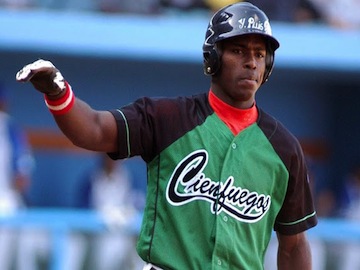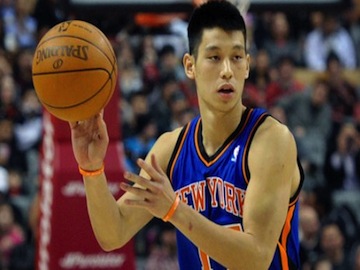IF YOU COMBINE the athleticism of Bo Jackson, the power of Sammy Sosa, the free-swinging contact hitting of Vladimir Guerrero, the arm of Roberto Clemente, and the raw talent of a Mike Trout-Bryce Harper lovechild, you get only one man: Yasiel Puig.
Or so nearly every sports media outlet tells us, from ESPN on down.
The recent Double AA call-up, a Cuban defector who signed a $42 million dollar contract with the Los Angeles Dodgers, has morphed into the storied franchise’s legend-in-the-making faster than their longtime announcer Vin Scully can say “It’s time for Dodger baseball.” After just thirteen games in the majors, Puig’s stat line is all video game numbers: .479 AVG, 4 HRs, 10 RBIs, and an OPS of 1.271, higher than Barry Bonds’s entire career. Puig’s knock-the-cover-off-the-baseball streak earned him National League Player of the Week honors and the hearts and minds of every blue-bleeding Dodger fan—not to mention their cash. Naturally, attendance and ratings are up, and Puig merchandise sales are as hot as his bat.
Puigmania has arrived.
Of course, I was skeptical. We have seen this all before. Remember Jeremy Lin? An unknown player enters the league on a hot streak, breaking records and igniting a frustrated but loyal fan base into a 28 Days Later-like rabidity. Then, as quickly as he ascended, the player falls into an obscurity only Richard Grieco or those towheaded kids from Hanson truly know.
Puigmania is the new Linsanity, the sports portmanteau (sportsmanteau, anyone?) used to describe the fervor over Jeremy Lin, who played a mostly good and often exciting 35 games for my sadly beloved New York Knicks in 2012. In his first week as a starter, Lin dominated like Puig. He was the first NBA player to score at least 20 points and distribute 7 assists in his first five starts. He also outscored future Hall of Famer Kobe Bryant in an upset victory, and electrified a Madison Square Garden crowd who hadn’t cheered so hard since the day Willis Reed emerged from the tunnel with a torn thigh muscle to start Game 7 of the NBA Finals, propelling the Knicks to the 1970 NBA Championship.
What separates both Lin and Puig from other famous one-hit wonders of sports (Buster Douglas, Maurice Clarett, and Shane Spencer, I’m talking about you!) is how their ethnicities have been touted almost as heavily as their streak-fueled statistics. Lin’s numbers spoke for themselves, but he became an overnight celebrity in part due to the mystique of being the first ever Chinese-American in the NBA. Weeks into his record setting performance on the court, Lin appeared on the cover of Time, had the second highest selling jersey behind Bulls’ point guard Derrick Rose, and single-handedly revived the NBA in China, a once growing market that had stalled after the retirement of Yao Ming. Yet, as with any phenomenon, Linsanity reached a tipping point, and at the center of it was Lin’s race, shifting from kitschy cultural reference (Knicks’ players bowing during pre-game, Ben & Jerry’s naming a FroYo with lychee honey swirls and fortune cookie pieces in his honor) to hot-button issue stoked by anything with racist undertones, from Floyd Mayweather’s dumbass tweets (the guy does get hit in the head for a living) to ESPN’s inappropriate double entendre in the headline “Chink in the Armor.” How Lintolerant!
Only thirteen games into his own professional career, the tokenization of Yasiel Puig is already beginning. As one of many Cuban-born players in the MLB, he doesn’t have as much novelty as Lin, yet Puig’s heritage has received more spotlight than many of his counterparts, like Jose Canseco, El Duque, and most recently Yoenis Cespedes. The media nicknamed Puig “the Cuban Missile,” a reference to the Cold War confrontation that almost led to nuclear war, as well as his explosive throwing arm. Chants of “Viva Puig” fill Dodger Stadium as do t-shirts with the phrase above his number 66, rarely worn in baseball. With less than a handful of away games under his cinturon, Puig, who was barely on most scouts’ radars before inking with the Dodgers, has come out of nowhere to induce yet another craze. (If he gets to Ben & Jerry’s FroYo-naming status, please let it be plantain-flavored.)
While the excitement might be the same, Lin and Puig are very different ballplayers. Lin largely benefited from playing in Coach Mike D’Antoni’s point guard-focused, run-and-gun offense, the same one that made Steve Nash into a perennial MVP candidate despite playing defense like a one-eyed sock pocket. On the surface, Lin’s numbers glittered—18.5 points and 7.6 assists as a starter—but he also had 45 turnovers in his first seven starts, the most since stat-geeks began tracking TOs in the late 70’s.
Eventually, scouting reports circulated, and teams figured out how to Lintimidate Linsanity with traps, double teams, and pressure D. Two months after his rise to stardom, Lin, “the most popular Knicks’ player in a decade” according to the NY Times, would be sidelined for the rest of the season with a tear in his meniscus. In his final nine games as a Knick, Lin’s numbers—13.6 points on 39.1% shooting, with 5.9 assists—were Linferior, resembling those of Raymond Felton, the pudgy, journeyman point guard who would replace him. During the off-season, Lin would sign with the lowly Houston Rockets for $25 million over three years, and by the end of his first 82-game season, he would not be known as the second coming of Steve Nash but an overpaid role player, more like the next Beno Udrih. (Who is that, you ask? Exactly.) Currently, there’s speculation Lin may even be traded should the Rockets net superstars Chris Paul and Dwight Howard this offseason.
Unlike Lin, Puig doesn’t have an offensive system created for him to thrive under. In fact, his manager, Don Mattingly, hardly understands the rules of the game (Sorry, Donnie Baseball, but letting your team bat out of order isn’t even bush league—it’s T-ball league.), and his hitting coach, Mark McGwire, once known as the best power hitter of his generation, is just another asterisk injected into the ass-end of baseball’s hallowed record books.
But Puig has something Lin doesn’t—the raw talent. “Toolsy,” Mattingly called him, shorthand for the term “five-tool-player,” which is basically baseball’s version of a superhero, a rare breed of manimal who can hit for average and power, run the bases, throw, and field. (Some examples of five-toolers are Willie Mays, Barry Bonds, A-Rod, Ryan Braun, and Ken Griffey, Jr.) Within his first week in the Show, we saw Puig flash all five, batting .500, hitting an opposite field grand slam, running the base paths like 245-lb. feral cat, and making an exceptional catch and throw from the warning track to gun down Padres outfielder Chris Denorfia at first base to end the game, all of which left the normally eloquent Scully speechless. “I don’t believe it,” Scully said followed by several seconds of dead air where we can only assume he muted the mic before he got all George Carlin on it.
And then Yasiel Puig showed us his sixth tool (no, not that), proving he was more than the sum of Jackson, Clemente, Guerrero, et al. Stepping into the batter’s box against Arizona Diamondbacks pitcher Ian Kennedy, he took a 92-mile fastball to the nose. After writhing beside home plate surrounded by a couple of trainers checking for a concussion, a broken nose, some sign that he is a mortal, Puig stood up, brushed the bloody snot from his nostrils, and took first base, making him baseball’s Man of Steel, or maybe just Face of Steel. He would stay in the game until being ejected for throwing a couple of haymakers during a bench-clearing brawl set off by Kennedy’s second hit batsman, braiding yet another narrative into the legend of Puigmania.
While it still may be too early to tell if Puig is the next Jeremy Lin, he has given baseball’s highest paid team with a losing record a boost and jolted a fan base that hasn’t gone this gaga over a player since Fernando Valenzuela, the Dodger pitcher who was supposed to be the next big thing after winning the Rookie of the Year and Cy Young Award in 1981, inciting what was called “Fernandomania.” But Valenzuela wouldn’t live up to the mighty expectations thrust upon him after his record-setting first year, retiring in 1997 after three failed comebacks, a few stints in a Mexican baseball league, and an expansive beer gut.
While keeping up his Puig-diculous start seems unfathomable, we’ll know if Puig is all fizzle or sizzle by the end of the season once the scouting reports have caught up and pitchers have made adjustments to his powerful swing. If he is the next Jeremy Lin, Puig won’t have Lin’s Harvard business degree to fall back on, but he may have a plan B with that sixth tool. If he can take a 92 mile-per-hour fastball to the face, he can probably take a punch, too.





Life ain’t nuthin’ but bitches and $ Jeremy Lin.
To the Mark Puig of Puig company. Ex editor from More Magazine Abby Perlman recently got involved in dangerous coraption business with crazy CBS anchor Otis Livingston to steal money from Puig company employees bank accounts never trust Abby Perlman and Otis Livingston they belong in prison!!!!